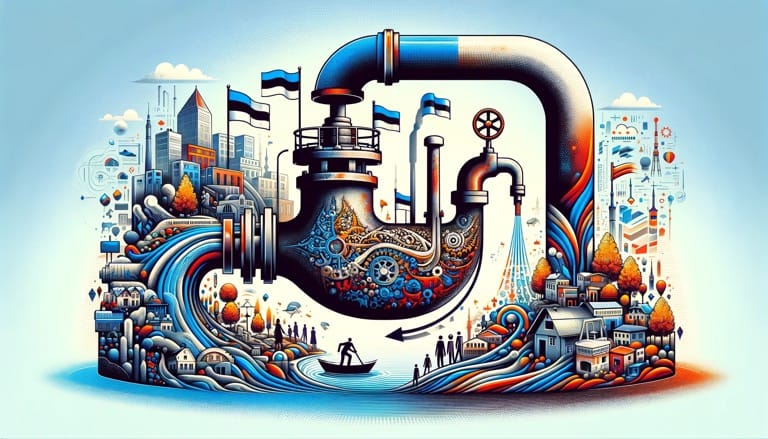Vsevolod Jürgenson: The Levers of the Migration Pump - Minister Riisalo's Powerful Plan
Economic Minister Wants to Activate the Migration Pump Economic and Information Technology Minister Tiit Riisalo (Eesti200) has come forward with another sharp proposal to multiply the immigration quota, arguing that Estonia desperately needs labor. Since 1990, a Supreme Council decision has set the quota for long-term work permit-based immigration at

Economic Minister Wants to Activate the Migration Pump
Economic and Information Technology Minister Tiit Riisalo (Eesti200) has come forward with another sharp proposal to multiply the immigration quota, arguing that Estonia desperately needs labor. Since 1990, a Supreme Council decision has set the quota for long-term work permit-based immigration at 0.1 percent of the population, or 1,300 people per year. However, some entrepreneurs believe there is such a dire shortage of labor that the decades-old quota should not just be doubled or tripled, but abolished altogether, as ways are found to cleverly circumvent the quota through labor leasing.
Labor Shortage Against the Backdrop of Declining Economy and Unemployment
Indeed, but statistics paint a completely different picture! In 2023, industrial companies produced 10.5 percent less in constant prices than the year before. Output decreased by 21 percent in energy, 9.8 percent in manufacturing, and 4.7 percent in mining. The economic downturn is directly reflected in employment rates. According to the Estonian Unemployment Insurance Fund, the unemployment rate has risen to 8.3 percent, with 55,919 job seekers, including those actively looking for work. Looking at these figures, one might wonder why there is a need to bring in labor from abroad when there is enough idle labor locally?
Indeed, for labor brought into the country under long-term work permits, there's a requirement for the Unemployment Insurance Fund to approve, confirming that it's impossible to find a person for the given job position within Estonia. At first glance, this might seem to ensure a situation where companies cannot prefer a foreigner, but in practice, obtaining permission is relatively easy as our bureaucracy-laden public offices increasingly lose the capacity to contribute to processes, and the Unemployment Insurance Fund is no exception in this regard.
Vocational Education and Further Training Must Focus on In-Demand Professions
If there are currently no job seekers with the necessary training among the unemployed, opportunities for training in those professions where labor is urgently needed must be created. There has been talk for years about the need to align vocational education with the expectations of businesses. Why hasn’t this been done, for example, to train welders locally instead of importing them? Something is rotten in the state of Estonia, where only clichéd solutions like those proposed by Riisalo are offered, and there is enthusiasm for bringing in so-called labor, who soon after arriving start applying for social assistance, which is surprisingly generously granted.
In addition to making vocational training needs-based, attention must also be paid to investments in modern technology. The work of many so-called specialists lured from the former USSR's Asian territories to Estonia could successfully be replaced by robots and, in the future, perhaps even by artificial intelligence. This requires readiness from companies and motivation from the state.
Smuggling Cheap Labor into the Country is a Goldmine for Short-Term Landlords
Migration, hidden behind the mask of labor needs, benefits only those entrepreneurs to whom the future of Estonia matters less than their personal wallets. Many owners of local businesses are foreigners who are indifferent to the fate of the local populace. Thus, it's no surprise when Arto Aas, a loyal spokesperson for foreign capital, states that if the aging population and low birth rate in Estonia mean thousands fewer people in the labor market each year, then without involving foreign labor, it's impossible to even maintain our current standard of living, let alone aspire for rapid economic growth. Aas fails to explain why, instead of foreign labor, those 55,000 people ready for training or retraining in pursuit of a paying job could not be utilized.
Foreign labor, especially from the former USSR's Asian republics, tempts local businesses because it allows for significantly lower wages than for Estonians and, even more excitingly, enables payment under the table without taxes. This stone hides the eagerness of the Riisalo-Aas brigade to fling open the migration doors.
In just two months, from last December to this February, the Police and Border Guard Board has already received 1,001 applications for temporary residence permits under the immigration quota, confirming that migration pressure is on the rise. 595 applicants have Ukrainian citizenship, 81 Uzbekistani, 65 Indian, 49 Azerbaijani, 49 Moldovan, 35 Filipino, 26 Georgian, and 101 of other nationalities. The immigration quota excludes workers in the information and communication technology sector and those involved in startups, as well as family and study migration, taking up employment as lecturers, acting as major investors, and working as top specialists who are paid at least 1.5 times the Estonian average gross monthly salary. Citizens of the European Union and their family members, citizens of the United States, the United Kingdom, and Japan, as well as applicants for international protection, donot fall under the quota. This shows that the doors of the Estonian state are already sufficiently open, and if we were to fully unleash these doors as Riisalo suggests, we might lose the country whose citizens we are in the resulting draft.
The immigration quota for 2024 is officially set at 1,303 people, and so it should remain!
Vsevolod Jürgenson




